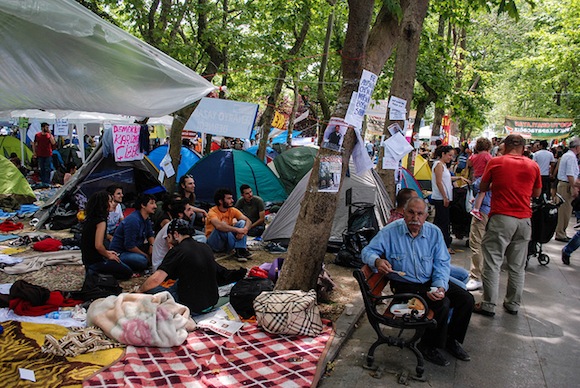In the aftermath of a tumultuous weekend in Istanbul, artist Merve Unsal reflects on the relationship between social media and the quotidian practice of protest.

Photograph by Ian Usher taken at Gezi Park on June 8, 2013, one week before the park was cleared by riot police backed by armored vehicles.
I grew up listening to what cities should and/or could be—my mother teaches urban planning at a public university in Istanbul, an institution whose beginnings in the late 19th century can be traced to the effort to change, adapt and preserve what was then the Ottoman Empire, and which later came to symbolize the (dis)continuity of modern ideals between the Empire and the Republic of Turkey. I learned about the neighborhood of Pera from architectural historian Dogan Kuban in efforts to make dinner conversation with my mom as a teenager. And yet, my relationship with the city that I lived in did not become tangible until May 30, 2013, when I went to Gezi Park after dinner.
The year 1980 is a generational point of demarcation in Turkey, a cut-off. The turmoil of the 1970s erupted in a military coup d'etat in 1980 that left an indelible mark on the generation that would become our parents; their generation was slapped—for lack of a better word—every ten years, 1960, 1971, 1980, even 1997. We—the kids born in the 80s—were raised to stay out of trouble.
[A recent survey in Gezi Park reveals that this is the first protest for many of the occupiers.]
Trouble found us, as the tents of peaceful protesters were burnt at dawn on May 31. Most of us watched the video of how the police treated the protestors in bed from our iPhones. The distance engendered by the media was negated by the spatial collapse—this place was a few minutes from our homes or offices. The neighborhood I was told to stay away from as a teenager, that then became a place of comfort and familiar chaos when I lived abroad and came to visit and was now a part of my day on most days.
The next couple of weeks—including today, when I'm writing this—became a testament to a self-organized movement that none of us knew we were capable of. Our networks of young professionals became more than Linkedin or Facebook connections as information was exchanged on every possible aspect of what could be needed in a range of scenarios. In a couple of days, we all knew what to do if we were taken into custody. Allergic reactions to the tear gas brought out the long-sleeved, wrinkled linen shirts out from the backs of closets. We had identified the pharmacists who could be relied upon for information on anacids and other such quick fixes to feel better after being subjected to tear gas. Doctors were on the speed dial, hospitals were identified as for or against the protests within hours. Most importantly, we learned what each person could do and when, before the first weekend was over.
And yes, Twitter is a pain, to crudely summarize the ramblings of our PM earlier in the process. Fact checks and verification methods were put into place before we understood how; today, on day 20 of the protests, my Twitter feed is calmer, funnier, more directed, more strategic—Tariq Ali's words echo in my mind, his exhortation to withdraw in order to resist for longer, more powerfully.
When the camp at Taksim Square was re-established, the surprise element disappeared and (#)resistance became a part of our daily routine. Work meetings were arranged in the park as were naps and presentations on past work, to keep ourselves occupied. The pop-up library had issues of magazines I coveted. The park that I quickly paced through on my way home from Taksim had become familiar, personal and most importantly, occupied.
That is, until Saturday, June 15th, when the police again ravaged the park and its occupiers.
A community was produced in Gezi Park, tightly woven together less by social networks than by our practice of the daily, as well as the political agency that stemmed from the beautiful beginning of the movement, when urbanites claimed the park in the smack middle of their city square with the desire to protect it. Within hours, it became clear that the inability to stage a simple, peaceful protest to protect "a few trees" was enough to bring thousands out to the street; May 31st confirmed our worst fears. If not now, it would be never. Isolated thoughts and opinions quickly converged over Gezi Park as it is really that simple—a park cannot be demolished just like that, we needed to talk about it, and a ground for conversation was not provided until the sham of the PM's meetings with celebrities last Wednesday and Thursday.
Today, the park is declared to be open to the public once again, with shameful headlines condoning the police's "proportional intervention," their public service. The government's public is clearly the police (after all, it does feel like they outnumber non-police civilians on the street) as nobody else can enter the park at the moment. Walking in Taksim Square is *possible*, with stare downs par excellence between the pedestrians and the police. How do we expect a PM to act in the interest of the public when he is unclear on the meaning of the word interest?[1]
Our transformation is far from complete; at this stage, I'm just grateful to forces that may be (some extraterrestrial, some foreign intelligence agents, some political) for enabling me to engage in a way I didn't know I was capable of.
And while we have all become farce poets and comics in the past few weeks, Orhan Pamuk, his feeble response to the protests aside, arms me with an important thought to end with. "I don’t want to be a tree, I want to be its meaning." #out.
References: